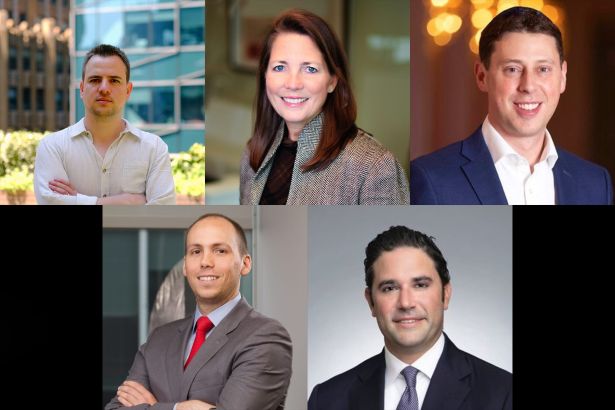Commercial Real Estate Financing Poised for Boom, CO Experts Say
By Mack Burke and Andrew Coen April 27, 2021 1:53 pm
reprints
Commercial real estate finance leaders are optimistic one year after the COVID-19 pandemic brought deal activity to a virtual standstill.
That’s according to panelists at Commercial Observer’s fifth annual Spring Financing CRE Forum in New York, who said on April 22 that while challenges remain, conditions are ripe for recovery across a number of real estate asset classes amid strong economic growth and record-low interest rates.
“Competition for loans, really, across all asset classes is robust,” Dustin Stolly, co-head of capital markets debt and structured finance at Newmark, said during the first panel, “A Fresh Outlook: A New Year, A New Economic Forecast From Top Market Participants.”
“We aren’t quite back to pre-pandemic levels, but interest rates are really low and borrowers are taking advantage of it,” he added.
Stolly noted that spreads across hospitality assets have compressed around 20 basis points during the last month, and there is also capital demand for other sectors hit hard during the pandemic. These include office buildings hosting large corporations with strong lease terms. He added that multifamily, industrial and life sciences are soaring with strong prospects for heavy lending activity in the near future.
Brian Ward, CEO of Trimont Real Estate Advisors, said his pessimism about a commercial real estate recovery has recently turned to optimism. He cautioned that recoveries of certain sectors, like lodging and retail, will hinge largely on forbearance agreements, though.
The first panel — which Mark Edelstein, chair of Morrison & Foerster’s global real estate group, moderated — also featured Warren de Haan, managing partner at Acore Capital; Brett Mufson, president of Fontainebleau Development; and Barbara Denham, senior economist at Oxford Economics.
Denham said New York City, like the U.S. in general, is projected to recover jobs lost during the pandemic She said that much of this growth will be driven by temporarily lost health care and social services positions, and the growth of technology companies. She noted that while hotel and restaurant jobs will also recover over the next year and a half, the tourism industry is expected to take three to four years before recovering.
New York City lost about 2 percent of its financial services jobs in 2020, but Denham said it should be able to narrow some of that gap from the technology sector’s growing presence in the market. She said life sciences growth would also be a key factor in New York’s recovery.
“We have been tested here,” Denham said of past challenges New York City has faced, such as the 9/11 terrorist attacks and the Wall Street crisis of 2008. “We have shown our mettle and think it gives us a lot of people confidence that New York City, especially, can recover from this recession because we have done so strongly in the past.”
As many CRE loans faced challenges during the past year, lenders learned how to better nurture relationships with borrowers that are helping them gain more access to the market now as the economy opens up more. Borrowers faced headwinds caused by construction delays during government shutdowns at the beginning of the pandemic and, in some cases, required loan modifications to navigate through the health crisis.
“At the end of the day, for us, it’s all about repeat borrowers and really being a good counterparty working with borrowers, giving latitude, giving time when you need to,” Josh Zegen, co-founder and managing director of Madison Realty Capital, said during the second panel, “Relationship Status: How COVID Is Shifting Lender & Borrower Dynamics & What that Adjustment Looks Like in a New Era.”
Zegen noted that the lenders who were best able to proactively assist borrower clients during the pandemic have been ones who were not over-leveraged and had sufficient flexibility to provide latitude when needed. He added that his team also took initiative with many “problem-solving” strategies with borrowers who encountered barriers with lenders.

Joel Traut, managing director of Kohlberg Kravis Roberts, said the credit market’s embrace of short-term forbearances was the right strategy in hindsight, given the massive economic toll and uncertainties surrounding how the crisis would affect valuations long term. Traut said forbearance requests are way down one year later in his firm’s portfolio, but cautioned they are still prevalent for such sectors as lodging, retail and Class B office.
“You have to have a balanced resolution with your borrowers in the instance where they are contributing something and the lender is contributing something to get to the other side,” Traut said. “You are going to continue to see these discussions occur, but I think at this stage now, we are starting to think more about what are the long-term implications of this on value and what is the right construct for negotiating solutions for our borrowers.”
The second panel — which Megan Vallerie, a partner in Seyfarth Shaw LLP’s New York office, moderated — also included Matthew Rosenfeld, head of U.S. debt at Cain International; Kevin Cullinan, managing director and co-head of credit strategies and head of investments at Mack Real Estate Credit Strategies (MRECS); and Drew Anderman, senior managing director at Meridian Capital Group.
Cullinan said the past year was an eye-opener on the importance of communicating with clients about preparing for a variety of unknown scenarios when closing transactions and helping them navigate the process. This year, MRECS is connecting prospective borrowers with existing clients to share their story about the strong business relationships that have been formed amid the clouds of COVID.
With many borrowers seeking more shorter-term or floating-rate offerings, traditional real estate lenders are facing more competition from insurance companies for investment strategies. While banks have been more selective as of late with lending, panelists expect them to soon be back to their normal capital levels with the economy opening up as more people get vaccinated.

Following the second panel, Sam Yen, head of commercial real estate digital at JPMorgan Chase, spoke about the role technology is playing in today’s CRE financing landscape, as part of a fireside chat hosted by Richard Sarkis, founder and executive chair of Reonomy.
The surge in vaccinations in the U.S. “put a defined timeline on when things would get back to normal, and it eliminated a lot of uncertainty,” said Starwood Property Trust Chief Originations Officer Dennis Schuh, who added that it’s evidenced in how well the equity markets have rebounded.
Heaps of capital that developed, even before the pandemic, have been on the sidelines raring to go, but while “everyone wants to bottom feed and buy at discount when a crisis hits,” Schuh said, “oftentimes the best strategy is time.”
Schuh spoke as part of the third panel, a five-person discussion titled, “Unleashing Pent-Up Activity: Does The Vaccine Hold The Key to Driving New Deals?” It was moderated by Cathy Cunningham, Commercial Observer’s co-deputy and finance editor, moderated.
Schuh was joined on the panel by Christopher Niederpruem, group head of real estate finance at CIT Group; Sonya Rocvil, principal and founder of Bedrock Real Estate Investors; Mike Sroka, CEO and co-founder of Dealpath; and Shaunak Tanna, head of structured investments at Basis Investment Group.
With the number of fully vaccinated people in the U.S. growing steadily, Niederpruem, who was speaking on the panel from a hotel room on the West Coast, said he’s seen overall deal activity increase in kind to start the year.

While asset classes like industrial and multifamily have remained strong through COVID-19, retail has now “turned the corner, in most cases, with collections,” Tanna said, adding that with leisure travel now driving a rebound in hospitality demand in many destination locations, it’s provided equity investors with the confidence needed to get back in the game, while having a similar effect on buyers of debt paper.
“We’re seeing quick changes in the behavior of people, and visibility into those behaviors and the related impact on the predictability of cash flows, causing an increase in transaction [volume],” Sroka said. “Underwriting has been tricky, but prices are being established.”
While the “water is warm right now,” according to Schuh, lender and investor appetite has certainly narrowed, Niederpruem said, highlighting the shift away from retail and into industrial, distribution and multifamily. Despite the relative risk-averse approach, the CIT executive said that bank lenders are starting to see repayment levels climb.
The discounts exist in the hotel and retail spaces, Tanna said, but his Basis Investment Group, which invests in mezzanine debt and preferred equity, is being “judicious about the amount of capital we dedicate to those areas.”
Still, Tanna said he traveled to Orlando for spring break with his family and did not expect what he experienced. Hotels were booked up, and his flights to and from the city were essentially full.
“I was surprised how robust the activity was,” he said.
“If you go to Florida now, [you might be] paying more than you did in 2019, and the hotels are full,” Schuh said. “The convention [center] business is being filled with leisure,” he added, but that area of hospitality will be the “last to come back,” although he said he has a colleague in Miami who was recently at the Loews Miami Beach Hotel, and saw group business there and attendees wearing name tags, which he said is a “good sign” of what’s to come.
And while there are shreds of positive movement on the leisure and business travel hospitality front, the book is still out on what the future holds for offices, especially in urban cores.
“The office landscape will be changed, whether that’s New York or generally, across the country,” Niederpruem said. “It’s difficult to underwrite, especially big urban centers. [We’re] looking at office deals, but with a more fine-tuned pencil to figure out how to see our way through.”
The market needs data before any meaningful moves are made on the office front, Schuh said, adding that the sector needs “leasing and investment sales activity to see where new valuations are. We’re cautious, as we’re supposed to be, waiting and watching.”
Overall, there are not a lot of deals on that front that are “being consummated yet, but that’s not due to a lack of interest,” Sroka said of investment sales.
On the new construction front, loan requests have been pouring in over the last six months, Niederpruem said. “Developers are optimistic by nature,” he said. “Most of the construction lending that’s getting done is around multifamily or industrial — most on a spec basis and a lot are built-to-suit for Amazon, and the like. It’s very competitive in the bank market.”
There’s less competition for new construction loans outside of the bank realm, due to the inherent equity risk in play, but bridge financing has ballooned, Schuh said. It will continue to have a significant place in the market until things stabilize, he added.
“[You] underwrite doing a lot of sensitivity around rents and occupancy, stressing those lower than the sponsor’s pro forma — that couldn’t be more relevant now — and stressing exit [cap rates] higher,” Schuh said. “The construction we’re looking to do is to best-in-class sponsors, [as] construction loans generally have a substantial amount of equity at risk.
Because of that, there’s “such a robust activity for bridge loans right now, so once [a project is] built, people are willing to take the risk on the lease-up of deals, even for office buildings, believe it or not,” Schuh added.
Many brokers have been pushing deals in high-growth secondary markets throughout the pandemic, and that remains true following the first quarter of this year, said Jonathan Schwartz, senior managing director and co-head of New York City capital markets at Walker & Dunlop.
“We’re pulling out to high-growth markets around the country, like Nashville and southern Florida,” Schwartz said. “[Our] clients are migrating out of major metros, like New York, and have gone down to those markets in an aggressive fashion. The uptick outside of major metros, that will continue … but major metros will certainly come roaring back.”
Schwartz said his group has refinanced two hotel assets in the last 45 days in Florida, one of which was in St. Petersburg: a $130 million, floating-rate loan from Blackstone at 65 percent of cost.
“It had good sponsorship … and COVID had an impact — there was a dip in occupancy and income — but its come roaring back pretty quickly,” he said.

Schwartz spoke as part of the fourth and final panel of the day, “High-Level Takeaways on Future Investment & Lending Trends.” He was joined by Midge Brogan, a managing director of commercial real estate debt at AllianceBernstein (AB) and CFO of AB’s CRE Income Fund; Jason Kollander, co-head of real estate credit at MSD Partners; Sebastian Post, a vice president of acquisitions at Fisher Brothers and a managing director at Lionheart Strategic Management. L.D. Salmanson, co-founder and CEO of real estate data firm Cherre, moderated the panel.
The migration of people, equity and debt capital to “high growth, low tax” markets created what Kollander called an “explosion” beyond core urban markets, but the magnetism of those major urban centers is inevitable, he said.
“They will attract significant capital, but it will take a few months to come back,” he said.
SL Green Realty Corp.’s recently announced $2.25 billion refinancing of its massive tower One Vanderbilt in Manhattan, a deal that could see the real estate investment trust cash out $1 billion, was a “testament to the New York City marketplace,” Post said. “Office is not dead, but urban cores will come back. Talented individuals happen to want to live in big cities.”
One Vanderbilt is, of course, a newly built, trophy behemoth full of credit tenants, the type of rosy picture that would provide certainty and make cash flows easier to underwrite, Schwartz said.
The struggle, Schwartz added, “is selling a value-add or lease-up play in urban markets. You mitigate that with sponsorship and good real estate fundamentals. We’ve been successful recently in selling the fact that COVID is a short-term blip in the grand scheme of the office market.”
For urban offices to lease up, landlords are going to need to provide more concessions, higher tenant improvement allowances and more free-rent periods, Kollander said. There will be a “flight to quality,” as higher-quality office buildings will be easier to lease up, he added.
“You can get the lender over the hump, structuring around the [rent] roll or underwriting a certain rent to get a loan done,” Schwartz said. “It’s not a bad time to borrow money, even in the office space, if you can sell the story.”
This is an edited and condensed version of the event.


